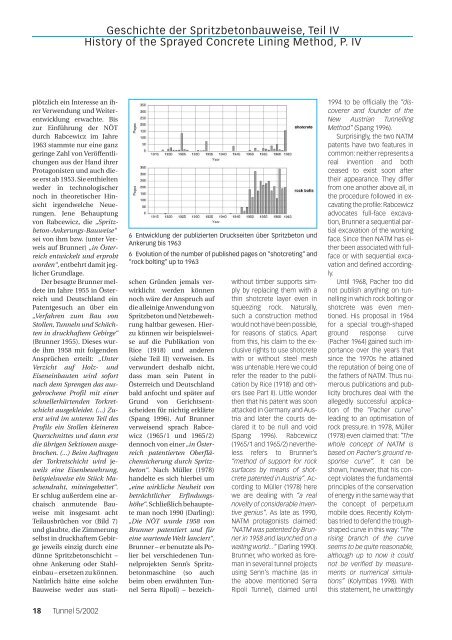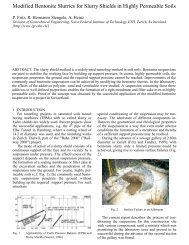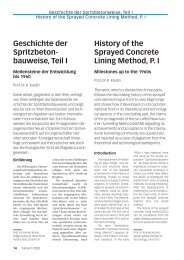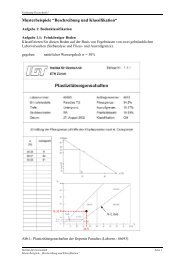Geschichte der Spritzbetonbauweise, Teil IV - ETH - IGT
Geschichte der Spritzbetonbauweise, Teil IV - ETH - IGT
Geschichte der Spritzbetonbauweise, Teil IV - ETH - IGT
Sie wollen auch ein ePaper? Erhöhen Sie die Reichweite Ihrer Titel.
YUMPU macht aus Druck-PDFs automatisch weboptimierte ePaper, die Google liebt.
plötzlich ein Interesse an ihrer<br />
Verwendung und Weiterentwicklung<br />
erwachte. Bis<br />
zur Einführung <strong>der</strong> NÖT<br />
durch Rabcewicz im Jahre<br />
1963 stammte nur eine ganz<br />
geringe Zahl von Veröffentlichungen<br />
aus <strong>der</strong> Hand ihrer<br />
Protagonisten und auch diese<br />
erst ab 1953. Sie enthielten<br />
we<strong>der</strong> in technologischer<br />
noch in theoretischer Hinsicht<br />
irgendwelche Neuerungen.<br />
Jene Behauptung<br />
von Rabcewicz, die „Spritzbeton-Ankerungs-Bauweise“<br />
sei von ihm bzw. (unter Verweis<br />
auf Brunner) „in Österreich<br />
entwickelt und erprobt<br />
worden“, entbehrt damit jeglicher<br />
Grundlage.<br />
Der besagte Brunner meldete<br />
im Jahre 1955 in Österreich<br />
und Deutschland ein<br />
Patentgesuch an über ein<br />
„Verfahren zum Bau von<br />
Stollen, Tunneln und Schächten<br />
in druckhaftem Gebirge“<br />
(Brunner 1955). Dieses wurde<br />
ihm 1958 mit folgenden<br />
Ansprüchen erteilt: „Unter<br />
Verzicht auf Holz- und<br />
Eiseneinbauten wird sofort<br />
nach dem Sprengen das ausgebrochene<br />
Profil mit einer<br />
schnellerhärtenden Torkretschicht<br />
ausgekleidet. (...) Zuerst<br />
wird im unteren <strong>Teil</strong> des<br />
Profils ein Stollen kleineren<br />
Querschnittes und dann erst<br />
die übrigen Sektionen ausgebrochen.<br />
(...) Beim Auftragen<br />
<strong>der</strong> Torkretschicht wird jeweils<br />
eine Eisenbewehrung,<br />
beispielsweise ein Stück Maschendraht,<br />
miteingebettet“.<br />
Er schlug außerdem eine archaisch<br />
anmutende Bauweise<br />
mit insgesamt acht<br />
<strong>Teil</strong>ausbrüchen vor (Bild 7)<br />
und glaubte, die Zimmerung<br />
selbst in druckhaftem Gebirge<br />
jeweils einzig durch eine<br />
dünne Spritzbetonschicht –<br />
ohne Ankerung o<strong>der</strong> Stahleinbau<br />
– ersetzen zu können.<br />
Natürlich hätte eine solche<br />
Bauweise we<strong>der</strong> aus stati-<br />
18 Tunnel 5/2002<br />
<strong>Geschichte</strong> <strong>der</strong> <strong>Spritzbetonbauweise</strong>, <strong>Teil</strong> <strong>IV</strong><br />
History of the Sprayed Concrete Lining Method, P. <strong>IV</strong><br />
6 Entwicklung <strong>der</strong> publizierten Druckseiten über Spritzbeton und<br />
Ankerung bis 1963<br />
6 Evolution of the number of published pages on “shotcreting” and<br />
“rock bolting” up to 1963<br />
schen Gründen jemals verwirklicht<br />
werden können<br />
noch wäre <strong>der</strong> Anspruch auf<br />
die alleinige Anwendung von<br />
Spritzbeton und Netzbewehrung<br />
haltbar gewesen. Hierzu<br />
können wir beispielsweise<br />
auf die Publikation von<br />
Rice (1918) und an<strong>der</strong>en<br />
(siehe <strong>Teil</strong> II) verweisen. Es<br />
verwun<strong>der</strong>t deshalb nicht,<br />
dass man sein Patent in<br />
Österreich und Deutschland<br />
bald anfocht und später auf<br />
Grund von Gerichtsentscheiden<br />
für nichtig erklärte<br />
(Spang 1996). Auf Brunner<br />
verweisend sprach Rabcewicz<br />
(1965/1 und 1965/2)<br />
dennoch von einer „in Österreich<br />
patentierten Oberflächensicherung<br />
durch Spritzbeton“.<br />
Nach Müller (1978)<br />
handelte es sich hierbei um<br />
„eine wirkliche Neuheit von<br />
beträchtlicher Erfindungshöhe“.<br />
Schließlich behauptete<br />
man noch 1990 (Darling):<br />
„Die NÖT wurde 1958 von<br />
Brunner patentiert und für<br />
eine wartende Welt lanciert“.<br />
Brunner – er benutzte als Polier<br />
bei verschiedenen Tunnelprojekten<br />
Senn’s Spritzbetonmaschine<br />
(so auch<br />
beim oben erwähnten Tunnel<br />
Serra Ripoli) – bezeich-<br />
without timber supports simply<br />
by replacing them with a<br />
thin shotcrete layer even in<br />
squeezing rock. Naturally,<br />
such a construction method<br />
would not have been possible,<br />
for reasons of statics. Apart<br />
from this, his claim to the exclusive<br />
rights to use shotcrete<br />
with or without steel mesh<br />
was untenable. Here we could<br />
refer the rea<strong>der</strong> to the publication<br />
by Rice (1918) and others<br />
(see Part II). Little won<strong>der</strong><br />
then that his patent was soon<br />
attacked in Germany and Austria<br />
and later the courts declared<br />
it to be null and void<br />
(Spang 1996). Rabcewicz<br />
(1965/1 and 1965/2) nevertheless<br />
refers to Brunner’s<br />
“method of support for rock<br />
surfaces by means of shotcrete<br />
patented in Austria“. According<br />
to Müller (1978) here<br />
we are dealing with “a real<br />
novelty of consi<strong>der</strong>able inventive<br />
genius“. As late as 1990,<br />
NATM protagonists claimed:<br />
“NATM was patented by Brunner<br />
in 1958 and launched on a<br />
waiting world...“ (Darling 1990).<br />
Brunner, who worked as foreman<br />
in several tunnel projects<br />
using Senn’s machine (as in<br />
the above mentioned Serra<br />
Ripoli Tunnel), claimed until<br />
1994 to be officially the “discoverer<br />
and foun<strong>der</strong> of the<br />
New Austrian Tunnelling<br />
Method“ (Spang 1996).<br />
Surprisingly, the two NATM<br />
patents have two features in<br />
common: neither represents a<br />
real invention and both<br />
ceased to exist soon after<br />
their appearance. They differ<br />
from one another above all, in<br />
the procedure followed in excavating<br />
the profile: Rabcewicz<br />
advocates full-face excavation,<br />
Brunner a sequential partial<br />
excavation of the working<br />
face. Since then NATM has either<br />
been associated with fullface<br />
or with sequential excavation<br />
and defined accordingly.<br />
Until 1968, Pacher too did<br />
not publish anything on tunnelling<br />
in which rock bolting or<br />
shotcrete was even mentioned.<br />
His proposal in 1964<br />
for a special trough-shaped<br />
ground response curve<br />
(Pacher 1964) gained such importance<br />
over the years that<br />
since the 1970s he attained<br />
the reputation of being one of<br />
the fathers of NATM. Thus numerous<br />
publications and publicity<br />
brochures deal with the<br />
allegedly successful application<br />
of the “Pacher curve”<br />
leading to an optimisation of<br />
rock pressure. In 1978, Müller<br />
(1978) even claimed that: “The<br />
whole concept of NATM is<br />
based on Pacher’s ground response<br />
curve“. It can be<br />
shown, however, that his concept<br />
violates the fundamental<br />
principles of the conservation<br />
of energy in the same way that<br />
the concept of perpetuum<br />
mobile does. Recently Kolymbas<br />
tried to defend the troughshaped<br />
curve in this way: “The<br />
rising branch of the curve<br />
seems to be quite reasonable,<br />
although up to now it could<br />
not be verified by measurements<br />
or numerical simulations”<br />
(Kolymbas 1998). With<br />
this statement, he unwittingly






